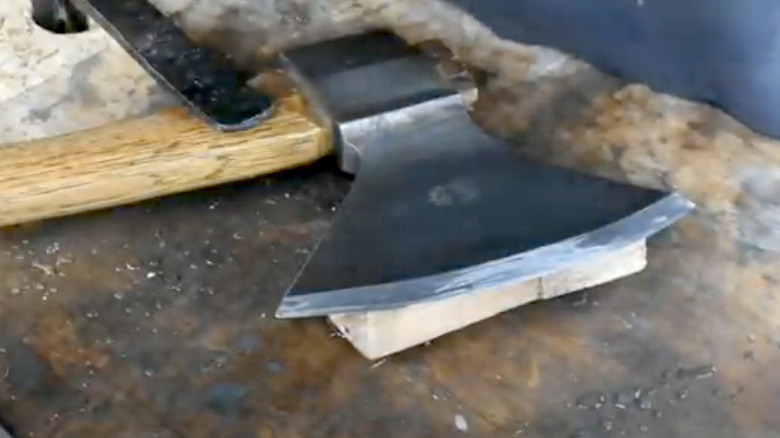Sharpen A Hewing Hatchet Like A Pro For A Razor-Edge Finish
We may receive a commission on purchases made from links.
At first glance, hewing hatchets look a lot like other axes, but they tend to have a broader blade that gives a longer cutting edge. They also have a bevel on one side only, not both. Hewing hatchets are popular with woodworkers who prefer a more traditional or rustic approach, using hand tools alone. That said, a similar sharpening technique will put a razor-edge finish on any axe.
If there's serious damage to the blade, a powered grinder or coarse hand files can be used to restore its basic shape, but in this article, we're concentrating on sharpening. It's not uncommon to see hatchets sharpened freehand, but for that razor-sharp edge, it's important to prevent the head from moving around. The hatchet needs to be clamped to a solid surface. If you're short of space, you might want to check out how to make a quick and easy DIY folding workbench.
The other things you need are a small block of wood a half-inch to an inch thick to support the blade, a clamp to hold the handle firmly on the bench, some water, paper towels, and some diamond stones. A set of 3 diamond stones from well-respected brand DMT is available at Amazon, and these are ideal. The bench can get very dirty from the sharpening residue, so you may want to protect it with a thin sheet of scrap ply and work on that.
Call up your inner Zen as you sharpen your hewing hatchet
Sharpening an axe or a hatchet doesn't need to be hard work and shouldn't be rushed. Steady, even pressure and concentration are key, not speed. Clamp the hewing hatchet down with the bevel side up. Take the coarsest diamond stone (300 to 400 mesh) and dip it in water to lubricate. Rather than working back and forward across the edge, follow the curvature around. This helps preserve that all-important bevel. Be very careful. If you slip, you might easily cut yourself. Rinse the stone occasionally and wipe the cutting edge clean with a paper towel.
After several minutes, you should see scratch marks that indicate you have worked the whole edge. You may also feel a little roughness — a burr — on the underside of the blade. Switch to a finer stone (around 600 mesh) and repeat the process. Then change to an extra-fine stone (1000 mesh or higher). By now you should have an almost mirror-like surface. Turn the hatchet over and remove the small burr on the back with a few strokes from the fine stone.
Those who want that ultimate razor-sharp finish can continue with a leather strop and polishing compound, following the same technique as for the diamond stones. It's a matter of personal preference. Some think it's overkill for a hatchet. This method can also be used for many garden tools that should be sharpened regularly, like spades and hoes, but just using coarse and fine stones.

